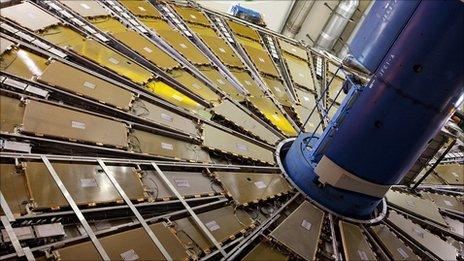Higgs speculation is 'premature'
- Published

The Atlas experiment is one of two multi-purpose experiments at the LHC
Speculation about a dramatic finding in the search for the elusive Higgs boson particle is premature, experts say.
An internal note leaked on the web reveals that a group of researchers at the Large Hadron Collider (LHC) has detected a signal compatible with the sought-after particle.
A spokesman for Cern, which runs the LHC, confirmed the note was authentic.
But he told the 91热爆 it had not been held up to proper scientific scrutiny and could turn out to be a false alarm.
The Higgs boson is of huge importance to the widely accepted theory of physics, known as the Standard Model.
It is the sub-atomic particle which explains why all other particles have mass.
However, despite decades trying, no-one, so far, has detected it.
The result under discussion originates from four members of the Atlas collaboration. Atlas is one of two "multi-purpose" experiments at the LHC designed to search for the Higgs, and some 3,000 physicists are working on the project.
'First stage'
Some observers have argued that the note could be a hoax, but Dr James Gillies, director of communications at Cern in Geneva, told 91热爆 News: "It's genuine, but what it comes from is a note written by a very small group of people in a large collaboration.
"There will be working groups for individual physics topics... within those working groups small teams of people will write notes for scrutiny by their colleagues.
"If those notes survive scrutiny, which is often not the case... then the next stage in the peer review process is for them to go out to the collaboration as a whole. If they survive that, then the collaboration will say: 'we've got something to go out to external peer review'."
Dr Gillies added: "What was leaked was the first stage in that process... at this stage we can't take it seriously and these things do come and go quite often."
The LHC is designed to smash together proton particles at close to light-speed in a bid to uncover new physics. Experiments such as Atlas look for "events" that could be associated with the production of new particles.
The Atlas researchers targeted a mass region of 115 gigaelectronvolts (GeV), where Higgs candidates had previously been observed by the LHC's predecessor - the Large Electron Positron (LEP) collider.
They observed a so-called "resonance", an effect which can be associated with the presence of sub-atomic particles.
But the number of events seen by the researchers was about 30 times greater than would be expected.
The note was originally physics blog by an anonymous user.
Another anonymous user on the blog commented: "Anything, especially garbage, can be published as a 'com' note. It's internal to the Atlas collaboration, not reviewed by anyone, not approved."
- Published28 February 2011
- Published10 January 2011
- Published14 July 2010